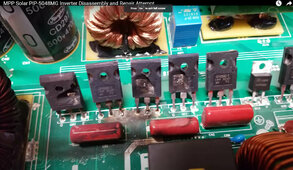While the LF inverter is doing grid assist, it is staying locked to the frequency from the grid, but pushing just enough power to feed the loads, but avoid drawing from grid. Now if the grid is disconnected, it seems to me you would get the effect you described when you said this:
If connected to grid, and inverter is not in standby mode, whether backfeeding, charging, or pass-through AC input to AC output, the inverter must be sync'd to AC input whenever pass-through relay is closed.
Even in standby mode, the controller pre-sync's to AC input so it knows how to active the inverter from standby, in phase sync with what the grid was before grid dropped out. This keeps AC output in proper sinewave phase progression, avoiding surge current that would happen from AC motor loads attached to AC output of inverter if there is a sudden AC phase shift discontinuity.
But I do know that the Schneider XWs open their relays instantly when the grid input breaker is opened. It just seems to me that the whole part of sensing the grid being there or not would operate the same way between LF vs HF.
It does open immediately if you are drawing significant AC input current to charge battery or AC output pass-through current. Inverters have two current measurement points to make this decision, AC input current and inverter current. AC output current is calculated value from these two measurement sensors.
If you have little to no current taken from AC input, it takes up to a couple of seconds to release pass-through relay. If you watch the AC output after you open AC input breaker, you will see the frequency rise on AC output before it releases pass-through relay. Inverter then becomes its own master again and slowly brings its frequency and voltage back to nominal inverter settings.
The inverter is slave to AC input voltage and frequency/phase when pass-through relay is closed, and the phase lock circuitry is biased to cause the inverter to gradually rise in frequency when AC input synchronization control is lost. One of the disconnect criteria is inverter frequency limit.
Primary criteria for releasing pass-through relay
- AC input current, under certain conditions such as charging, back feed, or load shaving.
- Lack of AC sinewave zero crossings phase lock correction pulses in a period of time (approx. two seconds).
- AC frequency drift outside of inverter set limits.
Inverter deciding when to release pass-through relay is not as easy as it may seem. Normal grid voltage glitches due to grid loads being turned on and off causes some grid voltage glitches all the time that causes some current surge and dips in inverter running in parallel with grid until either glitch disappears or inverter responds by readjusting its AC voltage output. Inverter voltage tracking response time is in the order of 50-80 msecs. Phase tracking response time is slower.



